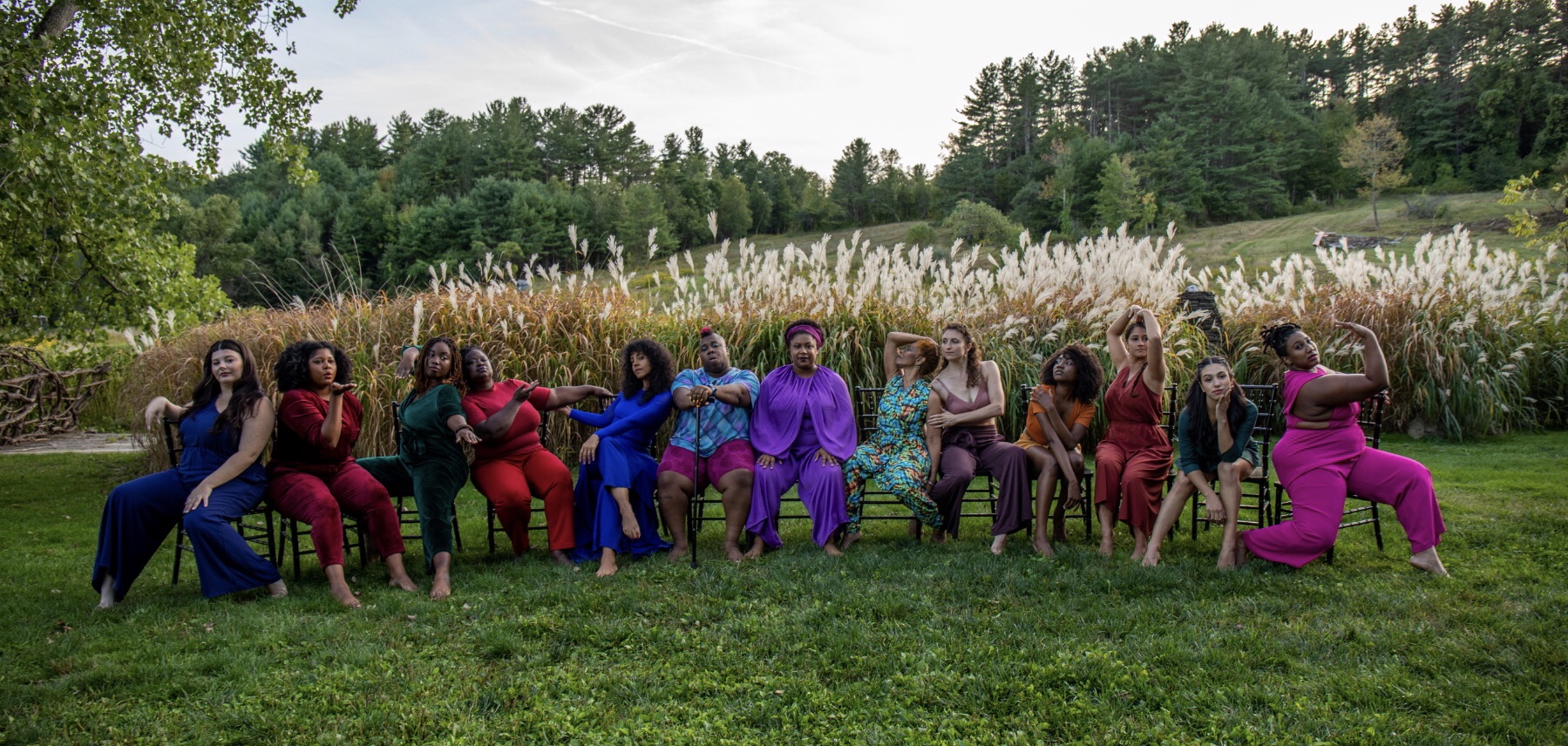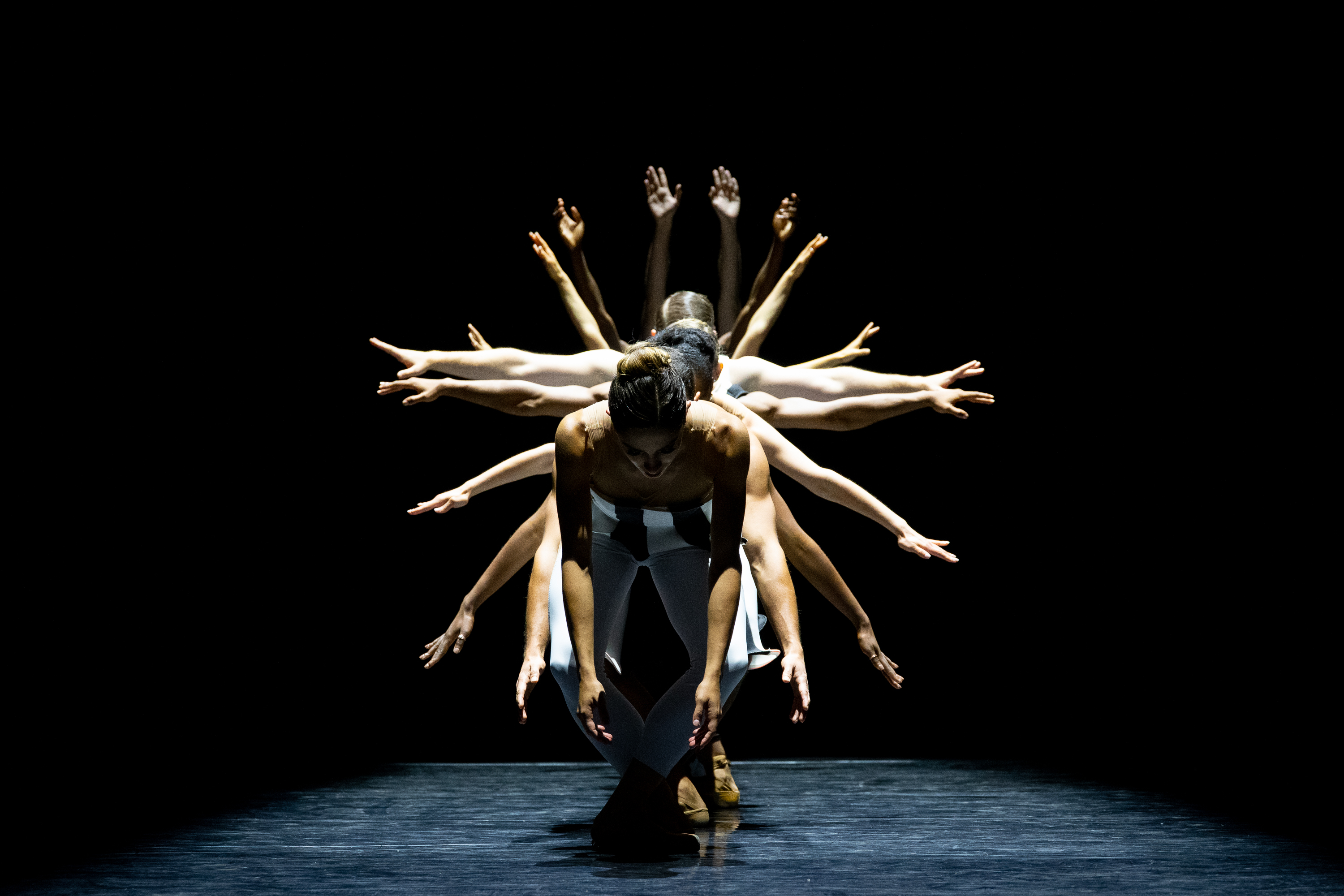NOT YOUR TYPICAL DYING SWAN
AND OTHER 30th ANNIVERSARY WORKS
BY URBAN BUSH WOMEN
By Luella Christopher, Ph.D.
American Dance Institute
Rockville, Maryland
April 1718, 2015
“Dark Swan” (2014) is beyond parody and distinctly so. Choreographer Nora Chipaumire, inspired by the Russian masters’s contributions to dance, gives the familiar “Dying Swan” by Michel Fokine a black and African twist with original, sassy evocations of the movements of swans. The piece begins with six female dancers facing upstage on parallel diagonals. Their backsides quiver incessantly like the feathers of a bird, an effect enhanced by flapping rows of greenishblack fabric designed by Zinda Lee Williams no tutus of white tulle here.
Gazing upward, arms to the back, the swans emit a collective gasp. Scuttling backward on their heels, still quivering and panting, they commence rapid, flatfooted stomping, slowly turning to face the audience. Dancer Tendayi Kuumba (a standout for her scat singing through “Hep Hep Sweet Sweet”, the evening’s first work) gasps and swallows her breath.
The dark swans replace Fokine’s fragile images with alternately spirited and dispirited attitudes. They are consistently selfassured and maybe a tad haughty. Stroking themselves provocatively, they plant their legs and feet in place, spread apart. Choreographer Chipaumire uses contained, minimalist moves to serve the much bigger notion of her own “mother/African/black women who refuse to wither away and die or die beautifully”. There’s opera in the sound score Bellini’s “Norma” (Maria Callas’ “Casta Diva”), as well as Sam Cooke’s “Bring It on Home to Me” and cellist Yo Yo Ma’s sublime rendering of Camille SaintSaens’ “The Swan”. A satisfying satirical riff on a sacred slice of ballet.
The 30th anniversary Urban Bush Women performance also features two jazz works. The first, “Hep Hep Sweet Sweet” (2014) by company founder Jawole Willa Jo Zollar, is “set in a fictional nightclub, a personal portrait drawing on the music and culture of the Great Migration”. Leaving the rural South for the cities of the North and Midwest, “transplants”often faced discrimination upon reaching their destinations. The bank even withdrew loans when Zollar’s father attempted to sell homes to blacks in white neighborhoods, forcing her family into an apartment.
Program notes explain that Zollar remembers her mother dabbing herself with “Evening in Paris”perfume and going out to places in Kansas City like the Orchid Room and the Blue Room. The largely ensemble piece utilizes the familiar compositions of “Parker’s Mood” by Charlie Parker, “Boogie Woogie” by Count Basie and His Orchestra and “E Blues” by Scrapper Blackwell, among others. Live music amplifies the sound design and is performed by George Caldwell and Lafayette Harris, Jr.
The most impressive aspect of “Hep Hep Sweet Sweet”is the scat singing by dancer Tendayi Kuumba. In postconcert conversation, Kuumba revealed that she superimposed pedestrian sounds on the scat technique of early American jazz artists. As a French hornist, I was happy to hear the dancer confirm that she adopted scat singing by copying the double and triple tongue feats that serious horn players (including trumpeters) must learn. On my way home afterwards, “scatted” as much as my own muscle memory could muster.
A recent addition to the company’s repertory, “Hep Hep Sweet Sweet” illustrates the founding mission of creating “story circles” around women in the African diaspora. Perspectives evolve from the desire to achieve social change and forge communities, often involving people who are not dancers. Urban Bush Women have even become American cultural diplomats on their globe-trotting tours.
The final work of the evening, “Walking with Trane, Chapter 2” (2014) features choreography by Zollar and Samantha Speis in collaboration with the company. It uses music by composer George Caldwell and movement inspired by the legendary jazz great John Coltrane’s “A Love Supreme”, first heard in 1965. Coltrane is often credited with transforming jazz by playing multiple notes at the same time in veritable “sheets of sound”.
Light patterns (gobos) in “Walking with Trane, Chapter 2” grace the floor as the dancers run in all directions and make sudden changes with the fury of ocean currents. In one section, they stretch arms upward and step over each other. The nonstop movement fits the pulsating music and even hints at charismatic spiritual awakenings as conveyed in one particularly long sequence of scatting. A single dancer remains silhouetted at the end as iridescent stars descend like snowflakes.
Improvisation from the pianist infuses the finale readily distinguishable from the actual strains of Coltrane. An energetic ensemble theater piece, though nearly overwhelmed by the commanding music. The company members, in addition to Kuumba, include Du’Bois A’Keen, Amanda Castro, Courtney J. Cook, Chanon Judson, Stephanie Mas and Samantha Speis.
Copyright © 2015 by Luella Christopher




